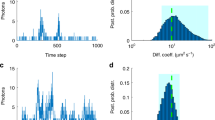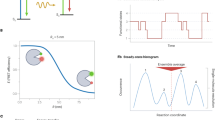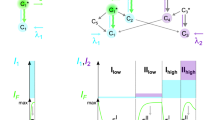Abstract
Dual-color fluorescence cross-correlation spectroscopy (FCCS) allows for the determination of molecular mobility and concentrations and for the quantitative analysis of molecular interactions such as binding or cleavage at very low concentrations. This protocol discusses considerations for preparing a biological system for FCCS experiments and offers practical advice for performing FCCS on a commercially available setup. Although FCCS is closely related to two-color confocal microscopy, critical adjustments and test measurements are necessary to establish successful FCCS measurements, which are described in a step-by-step manner. Moreover, we discuss control experiments for a negative cross-correlation artifact, arising from a lack of detection volume overlap, and a positive artifact, arising from cross-talk. FCCS has been applied to follow molecular interactions in solutions, on membranes and in cells and to analyze dynamic colocalization during intracellular transport. It is a technique that is expected to see new applications in various fields of biochemical and cell biological research.
This is a preview of subscription content, access via your institution
Access options
Subscribe to this journal
Receive 12 print issues and online access
$259.00 per year
only $21.58 per issue
Buy this article
- Purchase on Springer Link
- Instant access to full article PDF
Prices may be subject to local taxes which are calculated during checkout




Similar content being viewed by others
References
Bacia, K., Kim, S.A. & Schwille, P. Fluorescence cross-correlation spectroscopy in living cells. Nat. Methods 3, 83–89 (2006).
Larson, D.R., Gosse, J.A., Holowka, D.A., Baird, B.A. & Webb, W.W. Temporally resolved interactions between antigen-stimulated IgE receptors and Lyn kinase on living cells. J. Cell Biol. 171, 527–536 (2005).
Liu, P. et al. Investigation of the dimerization of proteins from the epidermal growth factor receptor family by single wavelength fluorescence cross-correlation spectroscopy. Biophys. J. 93, 684–698 (2007).
Kim, S.A., Heinze, K.G. & Schwille, P. Fluorescence correlation spectroscopy in living cells. Nat. Methods 4 (11), 963–973 (2007).
Schwille, P., Meyer-Almes, F.J. & Rigler, R. Dual-color fluorescence cross-correlation spectroscopy for multicomponent diffusional analysis in solution. Biophys. J. 72, 1878–1886 (1997).
Kim, S.A., Heinze, K.G., Bacia, K., Waxham, M.N. & Schwille, P. Two-photon cross-correlation analysis of intracellular reactions with variable stoichiometry. Biophys. J. 88, 4319–4336 (2005).
Hwang, L.C. & Wohland, T. Dual-color fluorescence cross-correlation spectroscopy using single laser wavelength excitation. ChemPhysChem 5, 549–551 (2004).
Jankowski, T. & Janka, R. ConfoCor2. The second generation of fluorescence correlation microscopes. in Fluorescence Correlation Spectroscopy: Theory and Applications (eds. Rigler, R. & Elson, E.L.) 331–345 (Springer, Berlin, 2001).
Weisshart, K., Jungel, V. & Briddon, S.J. The LSM 510 Meta-ConfoCor2 system: an integrated imaging and spectroscopic platform for single-molecule detection. Curr. Pharm. Biotechnol. 5, 135–154 (2004).
Sengupta, P., Balaji, J. & Maiti, S. Measuring diffusion in cell membranes by fluorescence correlation spectroscopy. Methods 27, 374–387 (2002).
Pan, X. et al. Multifunctional fluorescence correlation microscope for intracellular and microfluidic measurements. Rev. Sci. Instrum. 78, 053711 (2007).
Hess, S.T. & Webb, W.W. Focal volume optics and experimental artifacts in confocal fluorescence correlation spectroscopy. Biophys. J. 83, 2300–2317 (2002).
Petrov, E. & Schwille, P. State of the art and novel trends in fluorescence correlation spectroscopy. in Standardization in Fluorometry: State of the Art and Future Challenges (ed. Resch-Genger, U.) (Springer, Berlin, in the press).
Nagy, A., Wu, J. & Berland, K.M. Characterizing observation volumes and the role of excitation saturation in one-photon fluorescence fluctuation spectroscopy. J. Biomed. Opt. 10, 44015 (2005).
Gregor, I., Patra, D. & Enderlein, J. Optical saturation in fluorescence correlation spectroscopy under continuous-wave and pulsed excitation. ChemPhysChem 6, 164–170 (2005).
Enderlein, J., Gregor, I., Patra, D. & Fitter, J. Art and artefacts of fluorescence correlation spectroscopy. Curr. Pharm. Biotechnol. 5, 155–161 (2004).
Koppel, D.E. Statistical accuracy in fluorescence correlation spectroscopy. Phys. Rev. A Gen. Phys. 10, 1938–1945 (1974).
Saffarian, S. & Elson, E.L. Statistical analysis of fluorescence correlation spectroscopy: the standard deviation and bias. Biophys. J. 84, 2030–2042 (2003).
Chen, Y., Muller, J.D., So, P.T. & Gratton, E. The photon counting histogram in fluorescence fluctuation spectroscopy. Biophys. J. 77, 553–567 (1999).
Kask, P., Palo, K., Ullmann, D. & Gall, K. Fluorescence-intensity distribution analysis and its application in biomolecular detection technology. Proc. Natl. Acad. Sci. USA 96, 13756–13761 (1999).
Saffarian, S., Li, Y., Elson, E.L. & Pike, L.J. Oligomerization of the EGF receptor investigated by live cell fluorescence intensity distribution analysis. Biophys. J. 93, 1021–1031 (2007).
Hillesheim, L.N., Chen, Y. & Muller, J.D. Dual-color photon counting histogram analysis of mRFP1 and EGFP in living cells. Biophys. J. 91, 4273–4284 (2006).
Kask, P. et al. Two-dimensional fluorescence intensity distribution analysis: theory and applications. Biophys. J. 78, 1703–1713 (2000).
Rigler, R. & Elson, E.L. Fluorescence Correlation Spectroscopy: Theory and Applications (Springer, Berlin, 2001).
Haustein, E. & Schwille, P. Ultrasensitive investigations of biological systems by fluorescence correlation spectroscopy. Methods 29, 153–166 (2003).
Muller, J.D., Chen, Y. & Gratton, E. Fluorescence correlation spectroscopy. Methods Enzymol. 361, 69–92 (2003).
Bacia, K. & Schwille, P. A dynamic view of cellular processes by in vivo fluorescence auto- and cross-correlation spectroscopy. Methods 29, 74–85 (2003).
Krichevsky, O. & Bonnet, G. Fluorescence correlation spectroscopy: the technique and its applications. Rep. Prog. Phys. 65, 251–297 (2002).
Hess, S.T., Huang, S., Heikal, A.A. & Webb, W.W. Biological and chemical applications of fluorescence correlation spectroscopy: a review. Biochemistry 41, 697–705 (2002).
Thompson, N.L. & Steele, B.L. Total internal reflection with fluorescence correlation spectroscopy. Nat. Protoc. 2, 878–890 (2007).
Stoevesandt, O. & Brock, R. One-step analysis of protein complexes in microliters of cell lysate using indirect immunolabeling & fluorescence cross-correlation spectroscopy. Nat. Protoc. 1, 223–229 (2006).
Nishimura, G. & Kinjo, M. Systematic error in fluorescence correlation measurements identified by a simple saturation model of fluorescence. Anal. Chem. 76, 1963–1970 (2004).
Shaner, N.C., Steinbach, P.A. & Tsien, R.Y. A guide to choosing fluorescent proteins. Nat. Methods 2, 905–909 (2005).
Kohl, T., Heinze, K.G., Kuhlemann, R., Koltermann, A. & Schwille, P. A protease assay for two-photon crosscorrelation and FRET analysis based solely on fluorescent proteins. Proc. Natl. Acad. Sci. USA 99, 12161–12166 (2002).
Kogure, T. et al. A fluorescent variant of a protein from the stony coral Montipora facilitates dual-color single-laser fluorescence cross-correlation spectroscopy. Nat. Biotechnol. 24, 577–581 (2006).
Muller, B.K., Zaychikov, E., Brauchle, C. & Lamb, D.C. Pulsed interleaved excitation. Biophys. J. 89, 3508–3522 (2005).
Thews, E. et al. Cross talk free fluorescence cross-correlation spectroscopy in live cells. Biophys. J. 89, 2069–2076 (2005).
Baudendistel, N., Muller, G., Waldeck, W., Angel, P. & Langowski, J. Two-hybrid fluorescence cross-correlation spectroscopy detects protein–protein interactions in vivo. ChemPhysChem 6, 984–990 (2005).
Kohl, T., Haustein, E. & Schwille, P. Determining protease activity in vivo by fluorescence cross-correlation analysis. Biophys. J. 89, 2770–2782 (2005).
Kim, S.A., Heinze, K.G., Waxham, M.N. & Schwille, P. Intracellular calmodulin availability accessed with two-photon cross-correlation. Proc. Natl. Acad. Sci. USA 101, 105–110 (2004).
Kettling, U., Koltermann, A., Schwille, P. & Eigen, M. Real-time enzyme kinetics monitored by dual-color fluorescence cross-correlation spectroscopy. Proc. Natl. Acad. Sci. USA 95, 1416–1420 (1998).
Ohrt, T., Merkle, D., Birkenfeld, K., Echeverri, C.J. & Schwille, P. In situ fluorescence analysis demonstrates active siRNA exclusion from the nucleus by Exportin 5. Nucleic Acids Res. 34, 1369–1380 (2006).
Wohland, T., Friedrich, K., Hovius, R. & Vogel, H. Study of ligand-receptor interactions by fluorescence correlation spectroscopy with different fluorophores: evidence that the homopentameric 5-hydroxytryptamine type 3As receptor binds only one ligand. Biochemistry 38, 8671–8681 (1999).
Culbertson, C.T., Jacobson, S.C. & Ramsey, J.M. Diffusion coefficient measurements in microfluidic devices. Talanta 56, 365–373 (2002).
Petrov, E.P., Ohrt, T., Winkler, R.G. & Schwille, P. Diffusion and segmental dynamics of double-stranded DNA. Phys. Rev. Lett. 97, 258101 (2006).
Widengren, J. & Schwille, P. Characterization of photoinduced isomerization and back-isomerization of the cyanine dye Cy5 by fluorescence correlation spectroscopy. J. Phys. Chem. 104, 6416–6428 (2000).
Bacia, K., Majoul, I.V. & Schwille, P. Probing the endocytic pathway in live cells using dual-color fluorescence cross-correlation analysis. Biophys. J. 83, 1184–1193 (2002).
Weidemann, T., Wachsmuth, M., Tewes, M., Rippe, K. & Langowski, J. Analysis of ligand binding by two-colour fluorescence cross-correlation spectroscopy. Single Mol. 3, 49–61 (2002).
Bacia, K. & Schwille, P. Fluorescence correlation spectroscopy. in Lipid rafts (ed. McIntosh, T.J.) Chapter 7, 73–84 (Humana Press/Springer, Berlin; 2007).
Bacia, K., Schuette, C.G., Kahya, N., Jahn, R. & Schwille, P. SNAREs prefer liquid-disordered over 'raft' (liquid-ordered) domains when reconstituted into giant unilamellar vesicles. J. Biol. Chem. 279, 37951–37955 (2004).
Becker, C.F. et al. C-terminal fluorescence labeling of proteins for interaction studies on the single-molecule level. ChemBioChem 7, 891–895 (2006).
Ricka, J. & Binkert, Th. Direct measurement of a distinct correlation function by fluorescence cross correlation. Phys. Rev. A 39, 2646–2652 (1989).
Davis, L.M., Williams, P.E., Ball, D.A., Swift, K.M. & Matayoshi, E.D. Data reduction methods for application of fluorescence correlation spectroscopy to pharmaceutical drug discovery. Curr. Pharm. Biotechnol. 4, 451–462 (2003).
Acknowledgements
We thank Sally A. Kim for critical reading of the manuscript, Elke Haustein and Jonas Ries for helpful comments and former and current members of the Schwille lab for materials and discussions. This work was supported by the Volkswagen foundation, the German Ministry of Education and Research, the Human Frontiers Science Program and the European Regional Development Fund.
Author information
Authors and Affiliations
Corresponding author
Rights and permissions
About this article
Cite this article
Bacia, K., Schwille, P. Practical guidelines for dual-color fluorescence cross-correlation spectroscopy. Nat Protoc 2, 2842–2856 (2007). https://doi.org/10.1038/nprot.2007.410
Published:
Issue Date:
DOI: https://doi.org/10.1038/nprot.2007.410
This article is cited by
-
Mastering lanthanide energy states for next-gen photonic innovation
Science China Chemistry (2023)
-
α-Helical peptidic scaffolds to target α-synuclein toxic species with nanomolar affinity
Nature Communications (2021)
-
Tutorial: guidance for quantitative confocal microscopy
Nature Protocols (2020)
-
Measuring nanoscale diffusion dynamics in cellular membranes with super-resolution STED–FCS
Nature Protocols (2019)
Comments
By submitting a comment you agree to abide by our Terms and Community Guidelines. If you find something abusive or that does not comply with our terms or guidelines please flag it as inappropriate.



